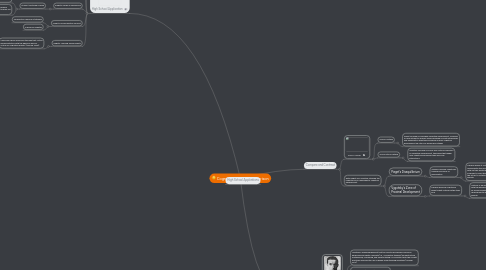
1. Compare and Contrast
1.1. Solo vs. Group
1.1.1. Clinical Method
1.1.1.1. Piaget focused on individual cognitive development, focusing on how student's develop meaning based on past experiences and equilibration eventually breaking up early cognitive development up into four hierarchical stages
1.1.2. Sociocultural Method
1.1.2.1. Vygotsky focused on social and cultural influences on cognitive development, theorizing that higher level cognitive processes begin as social interactions
1.2. Both Piaget and Vygotsky stressed the importance of challenges to cognitive development
1.2.1. Piaget's Disequilibrium
1.2.1.1. Children develop cognitively through a process of Equilibration
1.2.1.1.1. Children begin at a stage of equilibrium, when there existing schemes are capable of dealing with stimulus. They encounter a challenging new stimulus which cannot be dealt with via their existing schemes. This challenge and the resulting change and growth of the schemes to meet the challenge is called disequilibrium. After the resulting growth occurs the return to a state of equilibrium and complete the process of equilibration aka cognitive growth.
1.2.2. Vygotsky's Zone of Proximal Development
1.2.2.1. Children develop cognitively when taught material within their ZPD
1.2.2.1.1. Material or educational tasks that are too easy or too difficult to complete even with the guidance of an adult do not encourage cognitive growth. Tasks that can be accomplished via some guidance, tasks witch fall between a child's actual developmental level and level of potential development stimulate cognitive growth.
2. High School Applcations
3. High School Application
3.1. Vygotsky's Zone of Proximal Development
3.1.1. Teaching material that is challenging enough to promote growth and best accomplished via teacher's guidance or scaffolded throughout a lesson has become the norm
3.1.1.1. LDC Module: A supplementary unit of instruction which focuses on mini-tasks, each intended to teach or reinforce skill needed for some end goal
3.1.1.2. Gradual Release Model: A practice that stresses the gradual release of information based on modelling , guided practice, group work and finally individual "released" taks
3.2. Vygotsky's Social Interactions
3.2.1. Cooperative Learning Stratagies
3.2.1.1. Peer Evaluation
3.2.1.2. KAGAN is one of many curricular support systems that provides a variety of cooperative learning structures to pair with an existing lesson
3.3. Piaget's Hands on Experience
3.3.1. Student Centered Learnig
3.3.1.1. Formative Assessments
3.3.1.2. "Guide on the Side" has become a byword replacing "Sage on the Stage" or a teacher led model of instruction
3.4. Piaget's Sociocognitive Conflict
3.4.1. Cooperative Learning Stratagies
3.4.2. Classroom Debates
3.5. Piaget's Learning Environments
3.5.1. Classrooms have embraced the idea that "active experimentation with the physical world is critical for cognitive growth" (Ormrod 2008).
3.5.1.1. Tactile Learnig
3.5.1.2. Classroom Libraries
3.5.1.3. Classroom posters, displays, globes, etc.
4. 21st Century Perspectives
4.1. Vygotsky
4.1.1. Vygotsky's acknowledgement that the "mental processes involved in developing complete concepts (i.e., conceptual thinking) are abstracting, synthesizing, comparing, and differentiating" is consistent with the current practices involving the use of higher order thinking questions (Gredler 2012).
4.1.2. Various magnet schools, trade schools and colleges pair with corporations to allow for apprenticeship programs.
4.1.3. There is a current focus on cooperative learning and cooperative learning strategies consistent with Vygotsky's views.
4.2. Piaget
4.2.1. Skills within various domains are presented within a hierarchical framework with avenues for remediation and acceleration to cater to individual learners needs.
4.2.2. There is an obvious stress on hands on learning and interactive learning environments within contemporary education that owes a debt to Piaget.
